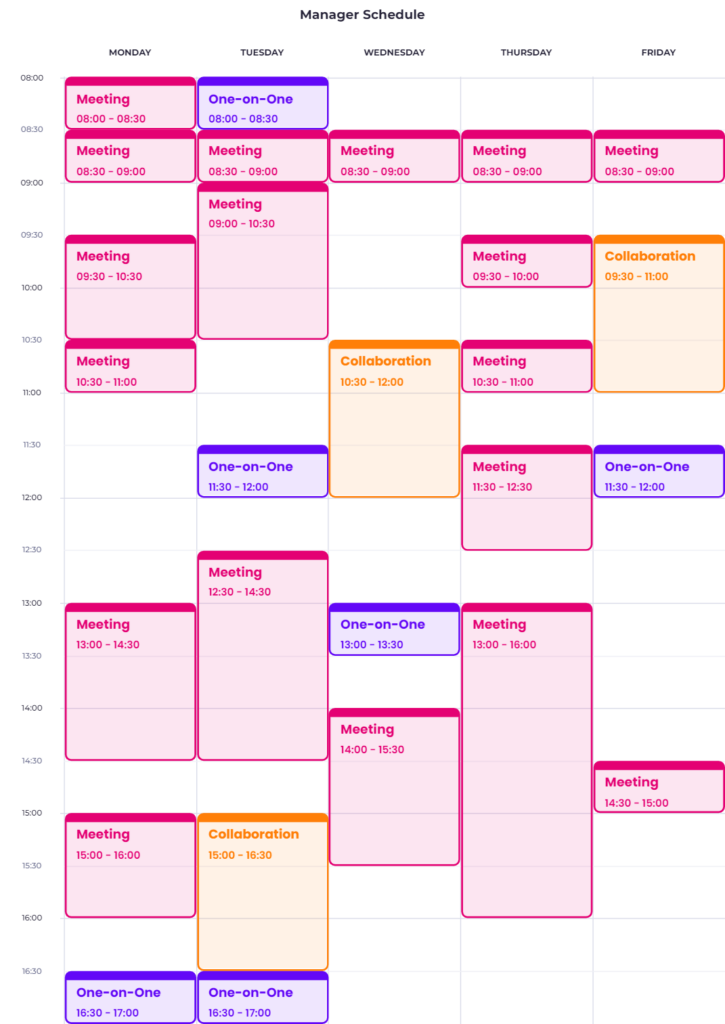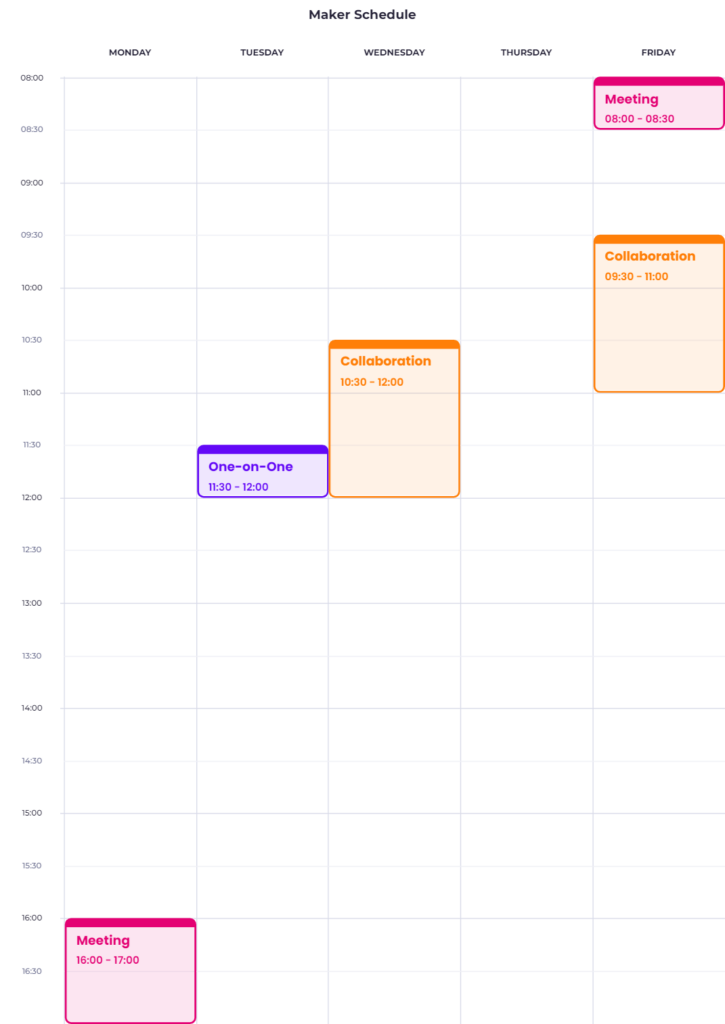In today’s dynamic workplace, you have probably grown accustomed to the busy day-to-day of a manager with its back-to-back meetings, impromptu issue resolution, and constant interruptions. Opportunistically, you cram as many emails, instant messages, and status updates into short breaks before hurrying to the next meeting. This is a typical work experience for a manager.
Most of your designers, architects, developers, and QA personnel cannot reach their productive potential with a work schedule like yours. Individuals engaged in deep, creative work require dedicated blocks of uninterrupted time. They need to reach a flow state where the task at hand holds their attention, and they are zoned in on it. Other distractions fall away. Increasing the time employees spend in flow by 15-20% can double overall workplace productivity and increase job satisfaction.

vs

30-minute or even 1-hour blocks of time are not productive for creative work. Researchers have found that getting to a flow state takes 15-30 minutes and lasts up to 2 hours. However, distractions reset the clock. When your employees talk about having such a productive day, it is probably when they can sit down and intensely focus on solving problems. You should be active in carving out as many opportunities as possible for your staff to reach a flow state. A Maker Schedule opens up these opportunities.
As a manager, you play a vital role in fostering productivity and maximizing the potential of your teams. It is crucial to recognize the value and unique requirements of the Maker Schedule to create an environment that fosters creativity and productivity. Understand that the Maker Schedule allows employees to achieve a flow state, delve into deep work, tackle complex projects, generate innovative ideas, and produce high-quality outputs. You can promote a workplace culture that values uninterrupted focus and helps employees be more productive.
Educate and Excite
Make sure employees are aware of their need to achieve a flow state. Share resources with them that emphasize how vital this time is. Then, get them excited to have longer blocks of time to be productive in their creative work.
Also, describe the difference between a meeting interruption and a collaboration with your employees. You are attempting to eliminate meetings. Collaborations are just deep focus time with multiple active employees. Embrace collaborations between employees, such as designing a new product feature. As much as possible, plan and schedule collaboration time to avoid interruptions to individual tasks. Also, remember that collaboration amongst some employees can also be a meeting for others who are not actively participating. Try only to invite active participants to a collaboration.
Remind your employees about the effectiveness of breaks as well. After 2 hours for a single session, it is time for a 15 to 20 minute break. Get up and walk around or grab a snack to recharge. Avoid emails, messaging, and colleagues if they intend to start another session immediately after their break. Also, remember that productivity begins to taper off after 4 hours of intense concentration during the day.
Be Flexible
Creating a productive Maker Schedule is a collaboration between the individual, their team members, and their manager. Work with individual employees to identify and schedule dedicated blocks of time for deep work that are effective for them. This can be an excellent topic for a one-on-one meeting. Aid teams in minimizing scheduling conflicts and ensuring employees have uninterrupted periods to immerse themselves in their creative tasks.
Consider your employees’ and your teams’ work styles as you collaborate. Do they start early and have short afternoons? If so, maybe afternoon meetings are better to keep the morning free. Maybe it isn’t until after lunch that they start feeling productive. If so, plan your one-on-ones with them at the start of their day. For teams with mixed preferences, meetings surrounding lunchtime can often accommodate both. Flexibility is key. Be sure to revisit this topic periodically as well. What worked 6-months ago may cause problems now. Or maybe the issues are cyclical. For instance, what works during the school year and the summer months may differ for employees with children.
Reduce Meeting Fatigue
Stop having meetings and move to more asynchronous information sharing. Most meetings are one-way information sharing. Fortunately, there are a lot of ways to share information. Instead of having stand-up meetings, share “Yesterday, Today, Blockers” updates each morning in Slack by a certain time. Instead of having an architecture review meeting, document the architecture, share the document, and ask for feedback. This allows the employee to provide or review information at a convenient time to avoid disruptions.
Keep essential meetings concise and focused. Avoid meetings longer than 30 minutes and strive for only 15 minutes. Try to find meeting times with employees at the start or end of a block of work time. Typically, this would be at the start of the day, right before and after lunch, and again at the end of the day.
Beyond reducing distractions, there are other advantages to intentional asynchronous information sharing. First, this type of information sharing is it is better documented and more searchable in the future. Second, it reduces meeting conflicts for managers and employees involved in multiple projects wanting updates. Third, it avoids an “always-on” culture.
Review Regularly
Routinely review the necessity and frequency of your meetings. Eliminate non-essential meetings. Ensure recurring meetings are still needed and advance their goals.
Also, review your employee’s calendars. Make sure they share them with you, and you can get an idea of what each meeting is for. It is also helpful to distinguish between meetings and collaborations by either color coding or titling the meetings to ascertain which is which quickly. If you have employees lacking sufficient focus time, work with them to cancel and reschedule meetings to regain the time they need.
Both of these activities should be done at least quarterly. Also, perform these reviews after significant changes in your employee’s work situations.
Empower the Employee
Employees will often get a meeting invite and accept without giving it much thought. It is imperative that they feel empowered to scrutinize and decline meetings where they do not feel they would receive or provide much value. This includes meetings that you may be setting up. Ensure your employees know this is part of their responsibilities. If your employees aren’t in control of their time, someone else will be.
Eliminate Other Distractions
Achieving a flow state is about more than just meetings. Encourage your employees to eliminate other distractions. Instead of dealing with emails as they come in, have employees work their emails in batches at a few scheduled times during the day. Have employees mark themselves as away or do no disturb in messaging systems. Turn on do not disturb in their OS. When working in the office, noise-canceling headphones and small private workspaces are necessary.
Be Ready for Setbacks
Going from a hectic schedule of meetings to one where a significant portion of the day is free for deep thought can be difficult. Focusing intently is a skill that must be built. Some people do not naturally have this skill. Work with them to strive for 30 to 60 minutes of flow state to start. Over time, their ability to focus for extended periods will grow.
Also, watch out for your staff that sabotages their co-worker’s flow. They likely don’t realize they are doing it, but they engage and distract their fellow employees. Remind these staff of the importance of the Maker Schedule and help them avoid distracting their co-workers.
Also, be mindful of the distractions you can cause. You may need information from one of your employees but ask yourself if what you need to know is urgent and important. Unless the answer is yes to both, ask via email and wait for their response. Be comfortable with not receiving immediate responses.
Recognize the Challenges for Employees with Leadership Skills
You probably have some senior staff responsible for leading projects, decision-making, and helping other team members. These senior leaders will likely have the highest productivity potential on your projects. Yet their actual individual productivity may be low. They likely have more distractions and find it harder to maintain a Maker Schedule. Thankfully, there are ways to balance their need for deep work time and the team’s need for skilled leadership. Be creative about achieving this balance. One technique to employ is the use of “office hours.” Instead of having interruptions at any random point during the day, schedule time on the calendar for team collaboration with their leads. Also, encourage your leaders to set expectations about when some of their activities will be performed. For instance, schedule time for when code reviews will be done each day. Then, instead of dealing with each code review as they come in, the lead deals with them in batches.
Senior staff members are also more likely to be involved in company initiatives outside their assigned projects across your organization. The best option in these cases is to push the meetings to early or late in the day. Build an organizational culture that embraces this increased productivity. If that is not possible, the next best alternative is to “turn into the skid,” and if the deep focus time is going to be lost, try to get as many other meetings scheduled around that time as possible. It is better to have a block of time wholly wrecked instead of multiple periods partially wrecked.
As a manager, embracing the Maker Schedule and providing the necessary support to employees operating on it can significantly enhance their productivity, creativity, and job satisfaction. By understanding the unique needs of creative workers, setting clear expectations, and fostering a culture that values deep work, managers can empower their employees to reach their full potential and drive innovation within the organization. With the right strategies and an open mindset, managers can create a harmonious balance between the Manager and Maker Schedules, ultimately leading to a more productive and successful team.



